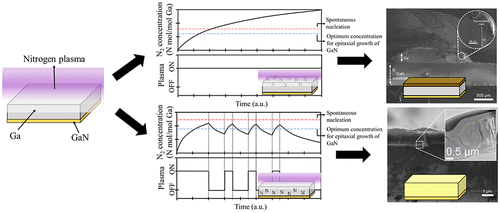当前位置:
X-MOL 学术
›
Cryst. Growth Des.
›
论文详情
Our official English website, www.x-mol.net, welcomes your
feedback! (Note: you will need to create a separate account there.)
Liquid Phase Epitaxy of Gallium Nitride
Crystal Growth & Design ( IF 3.2 ) Pub Date : 2019-09-27 , DOI: 10.1021/acs.cgd.9b01011 Daniel F. Jaramillo-Cabanzo , Jacek B. Jasinski , Mahendra K. Sunkara
Crystal Growth & Design ( IF 3.2 ) Pub Date : 2019-09-27 , DOI: 10.1021/acs.cgd.9b01011 Daniel F. Jaramillo-Cabanzo , Jacek B. Jasinski , Mahendra K. Sunkara

|
In this work, liquid phase epitaxy of gallium nitride (GaN) has been achieved using pulsed plasma nitridation of molten Ga films. Typically, continuous exposure of Ga to nitrogen plasma results in the formation of a thick GaN crust that prevents the growth of GaN layers on GaN seeds or GaN-on-sapphire substrates. The GaN crust formation on molten Ga is a consequence of a high concentration of dissolved nitrogen at the top surface of molten Ga layers. Here, we present the concept of using pulse (on/off) sequences to control the concentration of nitrogen inside the melt and enable the growth of GaN at the molten Ga–substrate interface. Results showed that the technique allows for epitaxial growth on homosubstrates and promotes the growth of additional layers on the pre-existing seeds. High-resolution transmission electron microscopy characterization confirmed epitaxial growth of GaN. A mass transport model was developed to discuss the effect of bulk recombination, diffusion, and pulsing on the concentration of nitrogen into the molten Ga. Results indicated that pulsing favored both the recombination of radicals in the bulk and the diffusion of species into the metal compared to the dissolution of radicals. As a result, the concentration of nitrogen at the surface of the metal is decreased, while the concentration of nitrogen at the molten Ga–substrate interface is increased, which allows for liquid-phase epitaxy of GaN.
中文翻译:

氮化镓的液相外延
在这项工作中,氮化镓(GaN)的液相外延已经通过熔融Ga膜的脉冲等离子体氮化实现。通常,Ga连续暴露于氮等离子体会导致形成厚的GaN结壳,从而阻止GaN层在GaN晶种或蓝宝石上的GaN衬底上生长。熔融Ga上GaN结壳的形成是熔融Ga层顶面上高浓度的溶解氮的结果。在这里,我们提出了使用脉冲(开/关)序列来控制熔体中氮的浓度,并使GaN在熔融Ga-衬底界面处生长的概念。结果表明,该技术允许在均质基质上外延生长,并促进预先存在的种子上其他层的生长。高分辨率透射电子显微镜表征证实了GaN的外延生长。建立了一个质量传输模型,讨论了本体复合,扩散和脉冲对氮在熔融Ga中的浓度的影响。结果表明,与脉冲相比,脉冲既有利于本体中自由基的重组,也有利于物种向金属中的扩散。分解自由基。结果,金属表面的氮浓度降低,而熔融的Ga-衬底界面上的氮浓度增加,这允许GaN的液相外延。结果表明,与自由基的溶解相比,脉冲作用既促进了本体中自由基的重组,也促进了物种向金属中的扩散。结果,金属表面的氮浓度降低,而熔融的Ga-衬底界面上的氮浓度增加,这允许GaN的液相外延。结果表明,与自由基的溶解相比,脉冲作用既促进了本体中自由基的重组,也促进了物种向金属中的扩散。结果,金属表面的氮浓度降低,而熔融的Ga-衬底界面上的氮浓度增加,这允许GaN的液相外延。
更新日期:2019-09-28
中文翻译:

氮化镓的液相外延
在这项工作中,氮化镓(GaN)的液相外延已经通过熔融Ga膜的脉冲等离子体氮化实现。通常,Ga连续暴露于氮等离子体会导致形成厚的GaN结壳,从而阻止GaN层在GaN晶种或蓝宝石上的GaN衬底上生长。熔融Ga上GaN结壳的形成是熔融Ga层顶面上高浓度的溶解氮的结果。在这里,我们提出了使用脉冲(开/关)序列来控制熔体中氮的浓度,并使GaN在熔融Ga-衬底界面处生长的概念。结果表明,该技术允许在均质基质上外延生长,并促进预先存在的种子上其他层的生长。高分辨率透射电子显微镜表征证实了GaN的外延生长。建立了一个质量传输模型,讨论了本体复合,扩散和脉冲对氮在熔融Ga中的浓度的影响。结果表明,与脉冲相比,脉冲既有利于本体中自由基的重组,也有利于物种向金属中的扩散。分解自由基。结果,金属表面的氮浓度降低,而熔融的Ga-衬底界面上的氮浓度增加,这允许GaN的液相外延。结果表明,与自由基的溶解相比,脉冲作用既促进了本体中自由基的重组,也促进了物种向金属中的扩散。结果,金属表面的氮浓度降低,而熔融的Ga-衬底界面上的氮浓度增加,这允许GaN的液相外延。结果表明,与自由基的溶解相比,脉冲作用既促进了本体中自由基的重组,也促进了物种向金属中的扩散。结果,金属表面的氮浓度降低,而熔融的Ga-衬底界面上的氮浓度增加,这允许GaN的液相外延。































 京公网安备 11010802027423号
京公网安备 11010802027423号